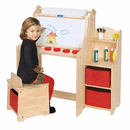Air Purifiers for Art Studios
Air Purifiers for Art Studios
Designers often use a phrase - “hierarchy of materials” when speaking of setting up a living space or work area. This phrase is true for artists who are, after all, also designers in their own right.
When setting up their studios, artists acquire the materials that lay the foundation of their art: easels, brushes, canvases, lighting, paints, oils, resins. They also must have one quiet corner where they can gaze at their work, refine it if necessary, and contemplate and dream for countless hours to fuel their creativity.
Being artists, they are focused on blending the elements of balance, beauty, harmony and shape. As H.L. Mencken said, “the true function of art is to criticize, embellish and edit nature.”
Ah, but nature has so many offspring, or by-products as environmentalists like to call them. Pollutants and toxic substances are one such by-product.
In the hierarchy of materials, therefore, air purifiers should make it to top of an artist’s list. Minute particles that float around should not be a hindrance to creativity. Air should be pure for art to flourish. Allerair may just be the product that will suit your needs.
Air purifiers were developed for fighting contaminants and allergens that float in space, and research has proven that there are more pollutants inside the home than outside. Purifiers integrate various methods to purify the air we breathe:
mechanical filters
absorbents
germicidal ultraviolet light
There are models, however, that are more efficient than others.
What factors should go into the purchase of a purifier? Design and cost, for one; maintenance, frequency of filter change, and noise are another. While one of the most expensive filters, HEPA filters do have a high efficiency rating, and the Department of Energy requires them to have the capacity to filter out 99.97% of the pollutants.
Allerair air purifiers were designed to meet these needs.
As an artist, your studio is a reflection of your spirit. Keep it free from the residuals of paints, adhesives, stone, inks, resins, acrylics and wax.
Purify your air and…your spirit…with an air purifier.
Why not try an Allerair product today?
* * *
Air Quality in the News
More Advances in Green Building
The National Association of Home Builders’ (NAHB) Green Building Conference recently took place in Albuquerque, New Mexico. Hot topics in sustainable building include more efficient HVAC systems, environmentally friendly materials, solar energy panels that can be concealed inside rooftops, thicker walls for better insulation and low-flow toilets. Innovative builders are looking toward the area’s indigenous peoples for building practices that take advantage of nature. Ray Tonjes, chairman of the NAHB, and local designer Armando Cobo point to indigenous homes built from adobe bricks positioned to take advantage of the sun’s rays. Other indigenous homes were built into mountain slopes to protect them from the north wind. The number of homes built according to green practices has increased fivefold since 2002.
Homes not built according to green practices may significantly improve indoor air quality through the use of AllerAir air purifiers.
From an article in The Chief Engineer online at chiefengineer .org
Indoor Air Quality in the Arts
The Balzer Theatre of Atlanta, Georgia has been awarded a Leadership in Energy and Environmental Design (LEED®) Silver certification from the U.S. Green Building Council, making it the first theatre in the United States to earn it. Theatre management, thrilled with the designation, point to the many advantages of having a healthy building, such as knowing that allergic and sensitive clients will be as comfortable as possible, and ensuring that the audience “doesn’t get oxygen-deprived and sleepy in act two.” Theatres in older buildings may achieve similar effects with AllerAir products installed.
From an article by Linda M. Eberle at gbj .com.
The Dangers of Radon
The naturally-occurring gas results from the decay of uranium in rock, water and soil. Previously considered a danger only to miners working deep inside the earth, radon is now known to occur above ground, and it is increasingly found in people’s homes. Radon breaks down into radioactive particles inside the lungs, increasing the risk for developing lung cancer by 11 to 21 percent. The same goes for Canada: on April 24 of this year, Health Canada introduced a proposal for new guidelines on indoor radon gas that are four times more stringent than the previous ones. "Poor indoor air quality can pose significant health risks. This recommended guideline is an important step in informing Canadians about the number one cause of lung cancer after smoking,” said Tony Clement, the Health Minister.
Radon gas can be reduced with HEPA and activated carbon filters.
From articles at uihealthcare.com and medicalnewstoday .com.
VOC Regulations affect Mainstream Manufacturers
Indoor air quality is increasingly on the agendas of state lawmakers. In January, 2005, VOC restrictions were imposed in Delaware, the District of Columbia, Maryland, New Jersey, New York, Pennsylvania and Virginia, according to the Benjamin Moore website. The manufacturer of household paint now makes low VOC products of its own. Low and no-VOC products were previously the domain of marginal companies catering to a limited clientele. Now that more and more customers, and lawmakers, are becoming aware of indoor air quality issues, even mainstream companies are forced to take notice.
AllerAir units are equipped to address most VOC concerns, including formaldehyde.
From pages at benjaminmoore .com.
Indoor Air Quality near Forest Fires and Wildfires
People living in regions affected by wildfire and forest fires should pay close attention to the quality of their indoor air. The Center for Disease Control (CDC) specifically recommends air purifiers equipped with HEPA filters to keep indoor air as clean as possible. Those with respiratory disorders, allergies, asthma, and COPD will be particularly susceptible to respiratory discomfort due to the amount of smoke produced by burning plants and trees. Other air quality measures include refraining from: smoking, burning wood or candles, and vacuuming.
AllerAir HEPA filters are DOP tested for quality. They are capable of trapping 99.97 percent of particles as small as 0.3 microns (1/233 the width of the average human hair), and their efficiency improves over time.
From an article at floridatoday .com.
Indoor Pool Fumes
Chlorine fumes at an Indiana indoor pool probably caused interstitial lung disease in a 55-year old volunteer. J.C. Davis, an airline pilot by profession, was likely exposed to toxic levels of fumes when he worked at a computer near a floor vent over the course of a four-day swim meet. His lawsuit cites chloramines, chlorine by-products that arise with heavy pool use, as a probable cause for his disease. The pool’s builder admits that chloramines have been a problem since state ventilation standards for indoor pools were adjusted in 1993. The new standards save money at the expense of indoor air quality, asserts a local veteran swim coach. While previous methods brought in fresh outdoor air at a rate of 100 percent day and night and exhausted pent-up fumes, the new standards dictated a combination of dehumidifiers and energy-conserving vents working together, reducing the rate of fresh air intake to just 20 percent during the day, and zero at night.
Mr. Davis’ doctors, after ruling out lung cancer, suspected chemical exposure as the likeliest cause of his disease, which may jeopardize his career.
Indoor pool management teams in Indiana have found success in reducing chloramines with the aid of UV light, a popular option available in most AllerAir models.
From an article by James A. Gillaspy at indystar .com.
Myth-Busting
The U.S. Environmental Protection Agency warns that ozone is a harmful gas, advising the public to seek out proven methods of air cleaning, and Health Canada recommends that owners of ozone generators stop using them. Neither of the two federal health agencies has approved ozone generating air purifiers, though some manufacturers of ozone generators go so far as to falsely indicate that they have won government approval. Buyer beware!
AllerAir air purifiers use proven methods to clean the air, and they generate no ozone.
From articles at epa .gov and hc-sc .gc.ca
www.MadisonArtShop.com
Designers often use a phrase - “hierarchy of materials” when speaking of setting up a living space or work area. This phrase is true for artists who are, after all, also designers in their own right.
When setting up their studios, artists acquire the materials that lay the foundation of their art: easels, brushes, canvases, lighting, paints, oils, resins. They also must have one quiet corner where they can gaze at their work, refine it if necessary, and contemplate and dream for countless hours to fuel their creativity.
Being artists, they are focused on blending the elements of balance, beauty, harmony and shape. As H.L. Mencken said, “the true function of art is to criticize, embellish and edit nature.”
Ah, but nature has so many offspring, or by-products as environmentalists like to call them. Pollutants and toxic substances are one such by-product.
In the hierarchy of materials, therefore, air purifiers should make it to top of an artist’s list. Minute particles that float around should not be a hindrance to creativity. Air should be pure for art to flourish. Allerair may just be the product that will suit your needs.
Air purifiers were developed for fighting contaminants and allergens that float in space, and research has proven that there are more pollutants inside the home than outside. Purifiers integrate various methods to purify the air we breathe:
There are models, however, that are more efficient than others.
What factors should go into the purchase of a purifier? Design and cost, for one; maintenance, frequency of filter change, and noise are another. While one of the most expensive filters, HEPA filters do have a high efficiency rating, and the Department of Energy requires them to have the capacity to filter out 99.97% of the pollutants.
Allerair air purifiers were designed to meet these needs.
As an artist, your studio is a reflection of your spirit. Keep it free from the residuals of paints, adhesives, stone, inks, resins, acrylics and wax.
Purify your air and…your spirit…with an air purifier.
Why not try an Allerair product today?
* * *
Air Quality in the News
More Advances in Green Building
The National Association of Home Builders’ (NAHB) Green Building Conference recently took place in Albuquerque, New Mexico. Hot topics in sustainable building include more efficient HVAC systems, environmentally friendly materials, solar energy panels that can be concealed inside rooftops, thicker walls for better insulation and low-flow toilets. Innovative builders are looking toward the area’s indigenous peoples for building practices that take advantage of nature. Ray Tonjes, chairman of the NAHB, and local designer Armando Cobo point to indigenous homes built from adobe bricks positioned to take advantage of the sun’s rays. Other indigenous homes were built into mountain slopes to protect them from the north wind. The number of homes built according to green practices has increased fivefold since 2002.
Homes not built according to green practices may significantly improve indoor air quality through the use of AllerAir air purifiers.
From an article in The Chief Engineer online at chiefengineer .org
Indoor Air Quality in the Arts
The Balzer Theatre of Atlanta, Georgia has been awarded a Leadership in Energy and Environmental Design (LEED®) Silver certification from the U.S. Green Building Council, making it the first theatre in the United States to earn it. Theatre management, thrilled with the designation, point to the many advantages of having a healthy building, such as knowing that allergic and sensitive clients will be as comfortable as possible, and ensuring that the audience “doesn’t get oxygen-deprived and sleepy in act two.” Theatres in older buildings may achieve similar effects with AllerAir products installed.
From an article by Linda M. Eberle at gbj .com.
The Dangers of Radon
The naturally-occurring gas results from the decay of uranium in rock, water and soil. Previously considered a danger only to miners working deep inside the earth, radon is now known to occur above ground, and it is increasingly found in people’s homes. Radon breaks down into radioactive particles inside the lungs, increasing the risk for developing lung cancer by 11 to 21 percent. The same goes for Canada: on April 24 of this year, Health Canada introduced a proposal for new guidelines on indoor radon gas that are four times more stringent than the previous ones. "Poor indoor air quality can pose significant health risks. This recommended guideline is an important step in informing Canadians about the number one cause of lung cancer after smoking,” said Tony Clement, the Health Minister.
Radon gas can be reduced with HEPA and activated carbon filters.
From articles at uihealthcare.com and medicalnewstoday .com.
VOC Regulations affect Mainstream Manufacturers
Indoor air quality is increasingly on the agendas of state lawmakers. In January, 2005, VOC restrictions were imposed in Delaware, the District of Columbia, Maryland, New Jersey, New York, Pennsylvania and Virginia, according to the Benjamin Moore website. The manufacturer of household paint now makes low VOC products of its own. Low and no-VOC products were previously the domain of marginal companies catering to a limited clientele. Now that more and more customers, and lawmakers, are becoming aware of indoor air quality issues, even mainstream companies are forced to take notice.
AllerAir units are equipped to address most VOC concerns, including formaldehyde.
From pages at benjaminmoore .com.
Indoor Air Quality near Forest Fires and Wildfires
People living in regions affected by wildfire and forest fires should pay close attention to the quality of their indoor air. The Center for Disease Control (CDC) specifically recommends air purifiers equipped with HEPA filters to keep indoor air as clean as possible. Those with respiratory disorders, allergies, asthma, and COPD will be particularly susceptible to respiratory discomfort due to the amount of smoke produced by burning plants and trees. Other air quality measures include refraining from: smoking, burning wood or candles, and vacuuming.
AllerAir HEPA filters are DOP tested for quality. They are capable of trapping 99.97 percent of particles as small as 0.3 microns (1/233 the width of the average human hair), and their efficiency improves over time.
From an article at floridatoday .com.
Indoor Pool Fumes
Chlorine fumes at an Indiana indoor pool probably caused interstitial lung disease in a 55-year old volunteer. J.C. Davis, an airline pilot by profession, was likely exposed to toxic levels of fumes when he worked at a computer near a floor vent over the course of a four-day swim meet. His lawsuit cites chloramines, chlorine by-products that arise with heavy pool use, as a probable cause for his disease. The pool’s builder admits that chloramines have been a problem since state ventilation standards for indoor pools were adjusted in 1993. The new standards save money at the expense of indoor air quality, asserts a local veteran swim coach. While previous methods brought in fresh outdoor air at a rate of 100 percent day and night and exhausted pent-up fumes, the new standards dictated a combination of dehumidifiers and energy-conserving vents working together, reducing the rate of fresh air intake to just 20 percent during the day, and zero at night.
Mr. Davis’ doctors, after ruling out lung cancer, suspected chemical exposure as the likeliest cause of his disease, which may jeopardize his career.
Indoor pool management teams in Indiana have found success in reducing chloramines with the aid of UV light, a popular option available in most AllerAir models.
From an article by James A. Gillaspy at indystar .com.
Myth-Busting
The U.S. Environmental Protection Agency warns that ozone is a harmful gas, advising the public to seek out proven methods of air cleaning, and Health Canada recommends that owners of ozone generators stop using them. Neither of the two federal health agencies has approved ozone generating air purifiers, though some manufacturers of ozone generators go so far as to falsely indicate that they have won government approval. Buyer beware!
AllerAir air purifiers use proven methods to clean the air, and they generate no ozone.
From articles at epa .gov and hc-sc .gc.ca
www.MadisonArtShop.com
Copyright © 2002-2025 Madison Art Shop™ LLC. All Rights Reserved.

















